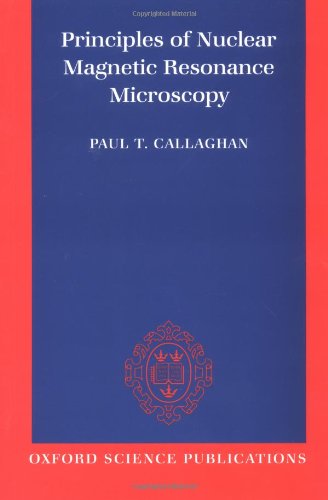Principles of Nuclear Magnetic Resonance Microscopy epub
Par prado joan le mercredi, juillet 20 2016, 08:40 - Lien permanent
Principles of Nuclear Magnetic Resonance Microscopy. Paul Callaghan

Principles.of.Nuclear.Magnetic.Resonance.Microscopy.pdf
ISBN: 0198539444,9780198539445 | 512 pages | 13 Mb

Principles of Nuclear Magnetic Resonance Microscopy Paul Callaghan
Publisher: Oxford University Press, USA
Download Free eBook:Protein NMR Spectroscopy: Principal Techniques and Applications - Free chm, pdf ebooks rapidshare download, ebook torrents bittorrent download. (1994) Principles of Nuclear Magnetic Resonance Microscopy, Oxford University Press. H NMR metabolic profiling was performed to distinguish the water extracts of P. Le Bihan studied NMR imaging intensively and suggested that diffusional movements of water and other molecules inside the body could be used to visualize microscopic structure and function of the organs and tissues being observed with MRI. Force-detected nuclear magnetic resonance: recent advances and future challenges. However, a proton and neutron will have lower energy when their spins are parallel, not anti-parallel, as this parallel spin alignment does not infringe upon the Pauli principle, but instead has to do with the quark structure of "Magnetic resonance microscopy: recent advances and applications". For instance, in 29Si NMR spectra of Au-C sample (Figure 2) four resonance lines at −96, −102, −108.3 and −113.6 ppm were identified, which correspond to Si(3Al), Si(2Al), Si(1Al) and Si(0Al) configurations, respectively [27]. The resulting response by the total magnetization (M) of the nuclear spins is the phenomenon that is exploited in NMR spectroscopy and magnetic resonance imaging. �Nuclear magnetic resonance is a key technology for determining the structure of molecules and for visualising the anatomy of living tissue and microscopic structure. Researchers increase NMR/MRI sensitivity through hyperpolarization of nuclei in diamond. We review recent efforts to detect small numbers of nuclear spins using magnetic resonance force microscopy. The principles and measurement techniques underlying Diffusion MRI are rooted in the classic formula proposed for Nuclear Magnetic Resonance (NMR) by E. It has helped revolutionise “The NMR operates under the same principles as magnetic resonance imaging (MRI, which many patients experience as part of modern medical procedures) but is powered by a superconductor and has a magnetic field 400,000 times stronger than the Earth's magnetic field. Callaghan, Principles of Nuclear Magnetic Resonance Microscopy (Clarendon Press, Oxford, 1993)[ Amazon][WorldCat]. An NMR technique tracks the diffusion of water molecules to obtain micron-scale structural information about a porous material. Ginseng cultivated in Hebei and Jilin of China, both of which were distinguished from extracts of P. Rainer Kimmich, NMR Tomography, and Diffusometry, Relaxometry (Springer-Verlag, Berlin, 1997)[Amazon][WorldCat]. The general principles of the magnetic imaging technique used here have been known for some time. The basic However, existing techniques either have poor spatial resolution compared to optical microscopy and are hence not generally applicable to imaging of sub-cellular structure (for example, magnetic resonance imaging), or entail operating conditions that preclude .